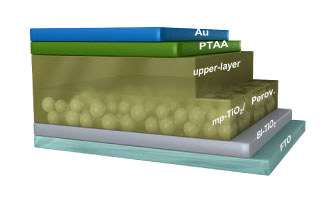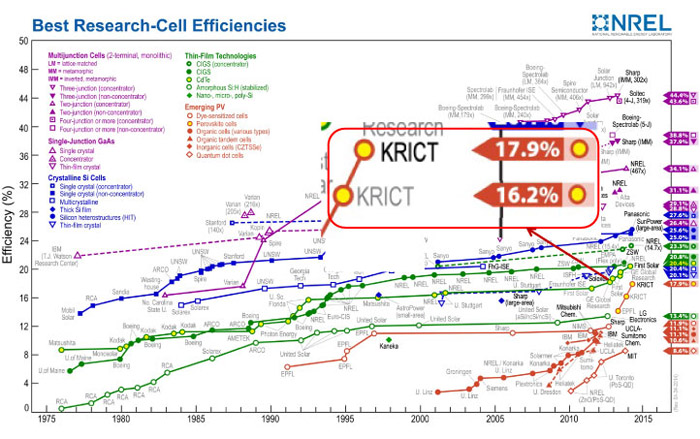Scientists at the Korea Research Institute of Chemical Technology (KRICT) have developed a structure for and the manufacturing technology for a mineral and organic hybrid Perovskite solar cell, the most efficient photovoltaic cell design in the world. It is expected to pave the way for the mass production of solar panels as efficient as currently existing silicon-based products.
A Perovskite structure is a unique combination of chemically synthetic mineral and organic materials. It has characteristics of both nonconductors and semiconductors, and is a superconductor. It was named after the Russian scientist Lev Perovski who discovered the material.

Existing silicon-based solar cells have a maximum efficiency of 20 percent, but due to their complicated manufacturing process and high production costs, electricity generation from solar energy is less economical than electrical power generation from fossil fuels.
In early 2013, the KRICT researchers developed a new mineral and organic hybrid Perovskite platform technology. Recently, they succeeded in defining the structure for a Perovskite solar cell and developed the related manufacturing technology, both of which are needed to produce a thin film, one of the core elements for the cell. The scientists then formed a printed circuit board with cheap mineral and organic materials and coated the board with the Perovskite-based thin film, thereby developing a Perovskite solar cell with an efficiency rate of 17.9 percent, currently the world's highest.
The U.S.-based National Renewable Energy Laboratory (NREL) has now officially confirmed the solar cell's efficiency for two years in a row: 16.2 percent in 2013 and 17.9 percent this year.

The research was made possible by financial support from the Ministry of Science, ICT and Future Planning and the results were published online in Nature Materials, a scientific journal, on July 6.
"We had difficulty in improving the efficiency level of the solar cells. This time, however, we succeeded in both dramatically enhancing the efficiency and in developing the associated manufacturing technology that will now cut production costs to one third that of existing silicon-based cell production costs," said a researcher at KRICT.
"When mineral and organic hybrid Perovskite solar cells are commercialized, along with the development of the manufacturing process and large-surface coating technologies, as well as related material, it will be as economical as generating electricity from fossil fuels."
By Limb Jae-un
Korea.net Staff Writer
jun2@korea.kr

A Perovskite structure is a unique combination of chemically synthetic mineral and organic materials. It has characteristics of both nonconductors and semiconductors, and is a superconductor. It was named after the Russian scientist Lev Perovski who discovered the material.

Multi-layer structure of mineral and organic hybrid Perovskite (image courtesy of the Global Frontier Center for Multiscale Energy System)
Existing silicon-based solar cells have a maximum efficiency of 20 percent, but due to their complicated manufacturing process and high production costs, electricity generation from solar energy is less economical than electrical power generation from fossil fuels.
In early 2013, the KRICT researchers developed a new mineral and organic hybrid Perovskite platform technology. Recently, they succeeded in defining the structure for a Perovskite solar cell and developed the related manufacturing technology, both of which are needed to produce a thin film, one of the core elements for the cell. The scientists then formed a printed circuit board with cheap mineral and organic materials and coated the board with the Perovskite-based thin film, thereby developing a Perovskite solar cell with an efficiency rate of 17.9 percent, currently the world's highest.
The U.S.-based National Renewable Energy Laboratory (NREL) has now officially confirmed the solar cell's efficiency for two years in a row: 16.2 percent in 2013 and 17.9 percent this year.

The U.S.'s renewable energy laboratory registered KRICT's mineral and organic hybrid Perovskite solar cell's efficiency rate at 16.2 percent in 2013 and at 17.9 percent in 2014. (image courtesy of the Global Frontier Center for Multiscale Energy Systems)
The research was made possible by financial support from the Ministry of Science, ICT and Future Planning and the results were published online in Nature Materials, a scientific journal, on July 6.
"We had difficulty in improving the efficiency level of the solar cells. This time, however, we succeeded in both dramatically enhancing the efficiency and in developing the associated manufacturing technology that will now cut production costs to one third that of existing silicon-based cell production costs," said a researcher at KRICT.
"When mineral and organic hybrid Perovskite solar cells are commercialized, along with the development of the manufacturing process and large-surface coating technologies, as well as related material, it will be as economical as generating electricity from fossil fuels."
By Limb Jae-un
Korea.net Staff Writer
jun2@korea.kr
Related Contents
Most popular
- Grammy-winning producer calls Suga of BTS 'amazing artist'
- Reunited BLACKPINK releases video preview of world tour
- 'Universal love, family' themes fuel success of 'King of Kings': director
- New York Times picks 'Parasite' as top movie of 21st century
- 'Deep rest, strong scent': forest boosts health, region's economy

